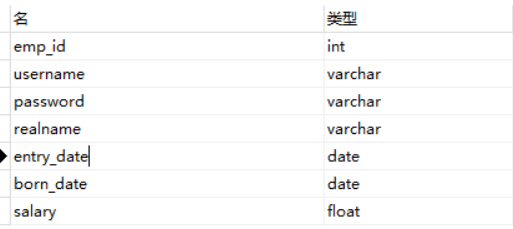一对一
需求:查询出员工的部门+员工的信息(一个员工对应一个部门)
1、建表
部门表(department)

员工表(employee)

2、新建两个类(Department和Employee)和接口
public class Department {
private Integer deptId;
private String deptName;
private LocalDate createDate = LocalDate.now();
private String deptLoc;
public class Employee {
private Integer empId;
private String username;
private String password;
private String realName;
private LocalDate bornDate;
private LocalDate hireDate=LocalDate.now();
private float salary;
private Department department;
public interface EmployeeMapper { /** * create by: * description:根据id查询员工信息 * create time: 2020/8/11 * * @Param: null * @return */ Employee efindById(int id); }
3、配置映射表、
对于结果的处理有两种方式:嵌套结果、嵌套查询
嵌套结果
<!--嵌套结果--> <resultMap id="employee" type="Employee"> <id property="empId" column="emp_id"></id> <result property="hireDate" column="entry_date"></result> <result property="username" column="username"></result> <result property="password" column="password"></result> <result property="bornDate" column="born_date"></result> <result property="salary" column="salary"></result> <!--assocaition来映射一对一的关联关系--> <association property="department" column="dept_id" javaType="Department"> <id property="deptId" column="dept_id"></id> <result property="deptName" column="dept_name"></result> <result property="createDate" column="create_Date"></result> <result property="deptLoc" column="dept_loc"></result> </association> </resultMap> <select id="efindById" parameterType="int" resultMap="employee"> select d.* ,e.* from department d,employee e where d.dept_id=e.dept_id and e.emp_id=#{empId}; </select>
嵌套查询
<!--嵌套查询--> <select id="efindById" resultMap="employee2"> select emp_id,entry_date,username,password,realname,dept_id from employee where emp_id = #{id} </select> <resultMap id="employee2" type="Employee"> <id property="empId" column="emp_id"></id> <result property="hireDate" column="entry_date"></result> <association property="department" select="edu.cduestc.book.Dao.DepartmentDao.findById" column="dept_id"> //这个column表示传递的参数。因为findById查询要使用dept_id这个值 </association> </resultMap> <select id="findById" resultMap="employee2"> select * from department where dept_id = #{dept_id} </select>
4、测试
一对多
需求:查询一个部门下有多少员工
1、表和上面一样不变
2、建立类和接口方法
1 public class Department { 2 private Integer deptId; 3 private String deptName; 4 private LocalDate createDate = LocalDate.now(); 5 private String deptLoc; 6 private List<Employee> employees;
1 public class Employee { 2 private Integer empId; 3 private String username; 4 private String password; 5 private String realName; 6 private LocalDate bornDate; 7 private LocalDate hireDate=LocalDate.now(); 8 private float salary;
1 public interface DepartmentDao { 2 Department findAllEmployee(int dept_id); 3 Department findAllEmployee2(int dept_id); 4 }
3、配置xml文件
嵌套结果
1 <!--嵌套结果查询--> 2 <select id="findAllEmployee" resultMap="getEmployeelist"> 3 select e.*,d.dept_name 4 from employee e,department d 5 where e.dept_id=d.dept_id 6 and e.dept_id=#{dept_id} 7 </select> 8 <resultMap id="getEmployeelist" type="Department"> 9 <id property="deptId" column="dept_id"></id> 10 <result property="deptName" column="dept_name"></result> 11 <collection property="employees" ofType="Employee"> 12 <id property="empId" column="emp_id"></id> 13 <result property="username" column="username"></result> 14 <result property="password" column="password"></result> 15 <result property="realName" column="realname"></result> 16 <result property="hireDate" column="entry_date"></result> 17 <result property="bornDate" column="born_date"></result> 18 <result property="salary" column="salary"></result> 19 </collection> 20 </resultMap>
嵌套查询
1 <!-- 嵌套查询--> 2 <select id="findAllEmployee2" resultMap="getEmployeelist2" parameterType="int"> 3 select dept_id,dept_name 4 from department 5 where dept_id=#{dept_id} 6 </select> 7 <select id="getEmployees" resultType="Employee" parameterType="int"> 8 select * 9 from employee 10 where dept_id=#{dept_id} 11 </select> 12 <resultMap id="getEmployeelist2" type="Department"> 13 <id property="deptId" column="dept_id"></id> 14 <result property="deptName" column="dept_name"></result> 15 <collection property="employees" ofType="Employee" column="dept_id" select="getEmployees"> 16 17 </collection> 18 </resultMap>
如果不太记得resultMap的具体使用可以参考以下的介绍
<!--column不做限制,可以为任意表的字段,而property须为type 定义的pojo属性--> <resultMap id="唯一的标识" type="映射的pojo对象"> <id column="表的主键字段,或者可以为查询语句中的别名字段" jdbcType="字段类型" property="映射pojo对象的主键属性" /> <result column="表的一个字段(可以为任意表的一个字段)" jdbcType="字段类型" property="映射到pojo对象的一个属性(须为type定义的pojo对象中的一个属性)"/> <association property="pojo的一个对象属性" javaType="pojo关联的pojo对象"> <id column="关联pojo对象对应表的主键字段" jdbcType="字段类型" property="关联pojo对象的主席属性"/> <result column="任意表的字段" jdbcType="字段类型" property="关联pojo对象的属性"/> </association> <!-- 集合中的property须为oftype定义的pojo对象的属性--> <collection property="pojo的集合属性" ofType="集合中的pojo对象"> <id column="集合中pojo对象对应的表的主键字段" jdbcType="字段类型" property="集合中pojo对象的主键属性" /> <result column="可以为任意表的字段" jdbcType="字段类型" property="集合中的pojo对象的属性" /> </collection> </resultMap>
collection标签使用的是嵌套查询
<collection column="传递给嵌套查询语句的字段参数" property="pojo对象中集合属性" ofType="集合属性中的pojo对象" select="嵌套的查询语句" > </collection>
参考:
https://blog.51cto.com/wuqinglong/1726152